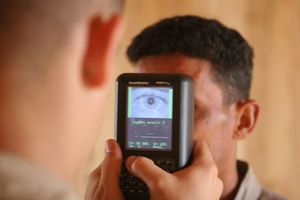Author: Aubrey Minshew, Museum Specialist, Truhlsen - Marmor Museum of the Eye®
Here at the Truhlsen-Marmor Museum of the Eye®, we have noticed a recent uptick in the popularity of iris photography—when a photographer takes a high-resolution photograph of a person’s eye and then edits it into an art print of their iris. In fact, this product has gotten so popular that people often mistake the museum for one of these photography studios. With this newfound popularity, it’s worth looking at the history of examining human irises, how people use the images today, and why we don’t offer this type of photography at the museum.

A human iris used in museum marketing
In 1893, a Hungarian scientist named Ignaz Peczely (1826–1911) produced the first known anatomically accurate drawing of a human iris. His accomplishment was accompanied by the dubious claim that he could “read” the unique features of an iris to detect disease or weakness in the body. Even more amazing, Peczely claimed to have discovered this link between iris features and health when he was just 11 years old! He was a boy when he noticed a black spot that appeared in the iris of an owl that had broken its leg. When he got older, he produced a full map of the ridges of the human iris and paired them with specific medical issues. This system of Augendiagnostik, generally translated as “iridology,” has been disproven by numerous scientific studies. In fact, we now know that iris texture develops in utero and our irises do not undergo significant changes as we age, other than the changes in babies’ eye color in early life or as a side effect of certain medications.

Iridology charts, 19th century
In the late 1800s, photography was not sophisticated enough to produce the kinds of iris photographs available commercially today, but images of irises were being made for identification purposes. M. Alphonse Bertillon (1853–1914), a French police officer and researcher, spent his career advocating for a criminal identification system based on specific body measurements (e.g. head length, head breadth, finger length). Bertillon recognized that iris color was a unique characteristic that could be measured and, in 1886, he suggested that irises could be used to catch repeat criminal offenders. His 1893 book, Identification anthropometrique, provided a detailed, hand drawn chart of what he saw as all the possible options for human eye color. His system of measurements, now considered to be an early form of biometrics, was eventually supplanted by fingerprint identification. Bertillon’s method of iris identification didn’t last but one of his innovations, the mugshot, remains a staple of criminal investigation.

"Table of the Nuances of the Human Iris" from Bertillon's 1892 book
As Bertillon observed, everyone’s “iris-print” is as unique as their fingerprint. Today, infrared cameras can be used to capture iris patterns in great detail. These images are then stored in computers and servers as unique biometric identifiers. The first iris recognition system was patented by two ophthalmologists in 1987. Since then, these systems have only gotten more precise and easier to access. An iris scan can now help you access a bank account, unlock a door or get you through airport security.

The Biometric Automated Tool Set (BATS) System, a U.S. military biometric processing system (2006)
So why don’t we offer iris photography at the Museum of the Eye? While the idea is fun, it’s a matter of security—specifically, your security. Your iris is so unique, it can be used in place of a password or passcode on some of the most valuable things in your life, such as your home or your bank account. The museum does not want to be responsible for keeping your biometrics safe. This is not to say that you shouldn’t seek out an iris photography studio, but it’s worth taking a look at how the company you choose protects, deletes or shares your biometric data.
While we are reviewing the history and uses of irises, let’s not forget to take a moment to appreciate that iris patterns aren’t just a biometric. They are also one of the many beautiful things that make you, uniquely you.